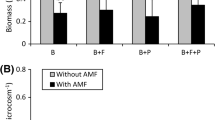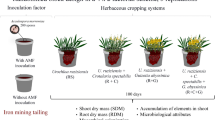Abstract
Industrial waste substrata, rich in heavy metals, are poorly suited for plant growth. Efforts are made to establish an appropriate plant cover to reduce erosion and further contamination. Grasses are the usual solution, as they grow fast, thrive on poor substrata and have well-developed root systems. Some of them are also highly dependent on mycorrhizal symbiosis that supports their growth especially on poor and polluted soils. However, the commercially available grasses often meet a lack of well established mycorrhiza on the site and the introduced plant populations dramatically decrease with time, despite large financial input including covering the substratum with soil and intensive watering. The aim of this paper was to select proper plants together with mycorrhizal fungi that could accelerate the establishment of the vegetation and improve its diversity under these extreme conditions, minimizing the financial costs of the reclamation (no use of soil layering and watering). The experiments were carried out under field and laboratory conditions. The plant seeds used originated from dry calcareous grasslands. The seeds were germinated under field conditions or in pots filled with soil supplemented with substratum from the industrial wastes. The seedlings were inoculated with AM fungi and introduced on the field plots a few weeks after germination. The inoculum consisted of either crude inoculum harvested from the dry calcareous grasslands or strains originating from polluted areas. Plants colonized by mycorrhizal fungi established well in the experimental plots. The results suggest that inocula from dry calcareous grasslands are potentially useful in revegetation of industrial wastes. Although in several cases the photosynthetic activity of plants was lower than at the natural sites, almost all plants survived and formed seeds. In all experiments the plant vitality was estimated on the basis of chlorophyll a fluorescence and was useful to show differences between waste substrata, inocula and coexisting plant species. The interactions between mycorrhizal and non-mycorrhizal plants were studied under greenhouse conditions and at least no negative effect of this coexistence was found.


Similar content being viewed by others
References
Bąba W (2004) The species composition and dynamics in well-preserved and restored calcareous dry calcareous grasslands (South Poland). Biologia (Bratislava) 59:447–456
Czarnecka J (2004) Seed longevity and recruitment of seedlings in dry calcareous grassland. Pol J Ecol 52:505–521
Day KJ, John EA, Hutchings MJ (2003) The effects of spatially heterogenous nutrient supply on yield, intensity of competition and root placement patterns in Briza media and Festuca ovina. Funct Ecol 17:454–463
Engqvist LG, Martensson A, Orlowska E, Turnau K, Belimov AA, Borisov AY, Gininazzi-Pearson V (2006) For a successful pea production on polluted soils, inoculation with beneficial microbes requires active interaction between the microbial components and the plant Acta Agr. Scand B-S P 56:9–16
Gange AC, Brown VK, Farmer LM (1990) A test of mycorrhizal benefit in an early successional plant community. New Phytol 115:85–91
Gange AC, Brown VK, Sinclair GS (1993) Vesicular–arbuscular fungi: a determinant of plant community structure in early succession. Funct Ecol 7:616–622
Góralska K (2007) Adaptation of selected plant species to growth on industrial wastes. In Polish. Master dissertation. Jagiellonian University. Krakow, Poland
Grime JP, Mackey JML, Hillier SH, Read DJ (1987) Floristic diversity in a model system using experimental microcosms. Nature 328:420–422
Grodzińska K, Korzeniak U, Szarek-Łukaszewska G, Godzik B (2000) Colonization of zinc mine spoils in southern Poland—preliminary studies on vegetation, seed rain and seed bank. Fragm Flor et Geobot 45:123–145
Hołynska B, Ostachowicz B, Ostachowicz J, Samek L, Wachniew P, Obidowicz A, Wobrauschek P, Streli C, Halmetschlager G (1998) Characterisation of 210Pb dated peat core by various X-ray fluorescence techniques. Sci Total Environ 218:239–248
Krüger GHJ, Tsimilli-Michael M, Strasser RJ (1997) Light stress provokes plastic and elastic modifications in structure and function of photosystem II in camellia leaves. Physiol Plant 101:265–277
Kwiecień M (2005) Influence of mycorrhiza on Aster amellus grown on substratum from zinc industrial wastes. Licence dissertation. In PolishJagiellonian University. Krakow, Poland
Medwecka-Kornaś A, Kornaś J (1977) Zespoły stepów i suchych muraw. In: Szafer W, Zarzycki K (eds) Szata Roślinna Polski. Part I. PWN, Warszawa, pp 355–363
Mirek Z, Piękoś-Mirkowa H, Zając A, Zając M (2002) Flowering plants and pteridophytes of Poland. A checklist. W Szafer Institute of Botany, Polish Academy of Sciences, Kraków, pp 442
Newsham KK, Fitter AH, Watkinson AR (1995) Arbuscular mycorrhiza protect an annual grass from root pathogenic in the field. J Ecol 83:991–1000
Orłowska E, Jurkiewicz A, Anielska T, Godzik B, Turnau K (2005a) Influence of different arbuscular mycorrhiza fungal (AMF) strains on heavy metal uptake by Plantago lanceolata (Plantaginaceae). Pol Bot Stud 19:65–72
Orłowska E, Ryszka P, Jurkiewicz A, Turnau K (2005b) Effectiveness of arbuscular mycorrhizal fungal (AMF) strains in colonisation of plants involved in phytostabilisation of zinc wastes. Geoderma 129:92–98
Phillips JM, Hayman DS (1970) Improved procedures for clearing roots and staining parasitic and vesicular–arbuscular mycorrhizal fungi for rapid assessment of infection. Trans Br Mycol Soc 55:158–161
Read D (1991) Mycorrhizas in ecosystems. Experientia 47:376–391
Roiloa SR, Retuerto R (2006) Physiological integration ameliorates effects of serpentine soils in the clonal herb Fragaria vesca. Physiol Plantarum 128:662–676
Roiloa SR, Alpert P, Tharayil N, Hancock G, Bhowmik PC (2007) Greater capacity for division of labour in clones of Fragaria chiloensis from patchier habitats. J Ecol 95:397–405
Ryszka P (2006) Mycorrhiza of grassses colonizing Trzebionka Mining Company zinc wastes. PhD dissertation. Jagiellonian University, Kraków
Ryszka P, Turnau K (2007) Arbuscular mycorrhiza of introduced and native grasses colonizing zinc wastes: implications for restoration practices. Plant Soil 298:219–229
Strasser RJ, Srivastava A, Govindjee (1995) Polyphasic chlorophyll a fluorescence transient in plants and cyanobacteria. Photochem Photobiol 61:32–42
Strasser RJ, Srivastava A, Tsimilli-Michael M (2000) The fluorescence transient as a tool to characterise and screen photosynthetic samples. In: Yunus M, Pathre U, Mohanty P (eds) Probing photosynthesis: mechanisms, regulation and adaptation. Taylor & Francis, London, pp 445–483
Strasser RJ, Tsimilli-Michael M, Dangre D, Rai M (2006) Biophysical phenomics reveals functional building blocks of plants systems biology: A case study for the evaluation of the impact of mycorrhization with Piriformospora indica. In: Varma A, Oelmuller R (eds) Advanced techniques in soil biology. Soil biology series. Springer, Germany, pp 220–221
Trouvelot A, Kough JL, Gianinazzi-Pearson V (1986) Mesure du taux de mycorhization VA d'un systeme radiculaire. Recherche de methodes d'estimation ayant une signification fonctionnelle. In: Gianinazzi-Pearson V, Gianinazzi S (eds) Mycorrhizae: Physiology and genetic aspects. INRA Press, Paris, pp 217–221
Turnau K (1998) Heavy metal content and localization in mycorrhizal Euphorbia cyparissias from zinc wastes in southern Poland. Acta Soc Bot Pol 67:105–113
Turnau K, Orlowska E, Ryszka P, Zubek S, Anielska T, Gawronski S, Jurkiewicz A (2006) Role of mycorrhizal fungi in phytoremediation and toxicity monitoring of heavy metal rich industrial wastes in Southern Poland. In: Twardowska I, Allen HE, Häggblom MM (eds) Soil and water pollution monitoring, protection and remediation. Springer, Dordrecht, pp 533–551
van der Heijden M (2002) Arbuscular mycorrhizal fungi as a determinant of plant diversity: in search of underlying mechanisms and general principles. In: van der Heijden MGA, Sanders I (eds) Ecological studies 157: Mycorrhizal ecology. Springer, Berlin–Heidelberg, pp 243–265
van der Heijden MGA, Boller T, Wiemken A, Sanders IR (1998) Different arbuscular mycorrhizal fungal species are potential determinants of plant community structure. Ecology 79:2082–2091
Acknowledgements
We greatly acknowledge Prof. Reto Strasser (University of Geneva, CH) for the tutorial on the Handy PEA use and data processing. Thanks are due to the Trzebionka Mining Company for allowing the field trials to be carried out. This work was supported by the Polish Ministry of Science and Higher Education (Grant No. 2 P04G 003 27) in years 2004–2007.
Author information
Authors and Affiliations
Corresponding author
Additional information
Responsible Editor: Peter Christie.
Rights and permissions
About this article
Cite this article
Turnau, K., Anielska, T., Ryszka, P. et al. Establishment of arbuscular mycorrhizal plants originating from xerothermic grasslands on heavy metal rich industrial wastes–new solution for waste revegetation. Plant Soil 305, 267–280 (2008). https://doi.org/10.1007/s11104-008-9563-y
Received:
Accepted:
Published:
Issue Date:
DOI: https://doi.org/10.1007/s11104-008-9563-y




